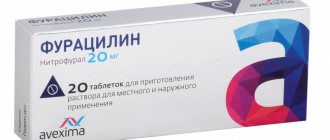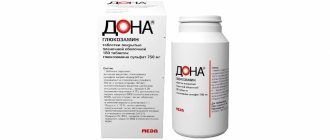Pharmacodynamics and pharmacokinetics
According to Wikipedia, a solution of potassium chloride is intended to restore water and electrolyte balance . In moderate doses, the drug has a negative bathmotropic and chronotropic effect, in higher dosages it is characterized by negative dromotropic and inotropic effectiveness, and also exhibits a moderately pronounced diuretic (diuretic) effect.
The introduction of small doses of potassium helps to dilate the coronary vessels , and the use of large dosages narrows . The use of potassium preparations enhances the transmission of nerve intercellular impulses , and in the case of intravenous administration, it helps to increase the secretion of adrenaline .
The drug activates a large number of cytoplasmic enzymes , corrects osmotic intracellular pressure, protein replication , skeletal muscle contractility and amino acid transport. Reduces conductivity , heart rate , contractile activity, excitability and automatism of the myocardium . Increasing the content of this microelement in the body reduces the possibility of toxic effects of cardiac glycosides .
Formula of potassium chloride and its properties
Potassium chloride formula: KCl.
Potassium salt is highly soluble in water, but remains in a crystalline state when mixed with vinegar, ethyl and methyl alcohol.
Potassium chloride is unable to form crystalline hydrates.
Potassium chloride is not prone to combustion. In terms of the degree of negative impact on humans and the environment, it belongs to class 3.
Potassium salt does not accelerate the formation of rust.
In the international classification, the substance is indicated under the index E508.
Physical properties of potassium chloride
| Parameter | Characteristics of the substance |
| Chemical formula | KCl |
| Names |
|
| Connection type | Inorganic |
| External characteristics | Homogeneous powder consisting of small crystals, similar to sugar |
| Color | White |
| Taste characteristics | Salty-bitter, unpleasant |
| Smell | Completely absent |
| Physical state under normal conditions | A solid substance, in pharmacology a solution of potassium chloride is used. |
| Density under normal conditions | 1984 kg/m3 |
| The temperature at which a substance begins to boil | 1407˚С |
| The temperature at which a substance begins to melt | 776˚С |
| Molar mass | 74.56 g/mol |
| Solubility in water under normal conditions (per 100 g of liquid) | 34.4 g |
| Hazard Class | 3 |
Chemical properties of potassium chloride
When it gets into water, potassium salt breaks down into its component ions.
KCl ↔ K+ + Cl—
The substance in question is capable of reacting with concentrated solutions of strong mineral acids and potassium perchlorate.
2KCl + H2SO4 (conc.) = K2SO4+ 2HCl↑
KCl + NaClO4= KClO4↓ + NaCl (t = 10 ˚C)
During the decomposition of the molten potassium salt, the formation of potassium is observed at the potassium cathode, and bubbles are observed at the chlorine anode. The substance turns into gas and evaporates.
2KCl = 2K + Cl2↑
Indications for use
The use of Potassium Chloride is indicated for:
- hypokalemia (including patients with diabetes mellitus , vomiting , prolonged diarrhea , as well as patients using glucocorticoids , some diuretics and antihypertensive drugs);
- prevention and treatment of paroxysmal tachycardia , glycoside intoxication , ectopic arrhythmias (in the acute period of myocardial infarction ).
What is potassium chloride
Potassium chloride is a simple inorganic compound also known as potassium salt or sylvite. The compound appears as a homogeneous white powder with visible crystals. It is characterized by a white or light gray color, a complete absence of odor and an unpleasant bitter-salty taste. Visually, potassium salt resembles sugar.
Potassium chloride crystals dissolve easily in ordinary water. In an alcohol medium and in acetone, the additive remains unchanged.
Potassium chloride is not only available in chemistry laboratories - it can be found in nature as large natural minerals. In addition, this substance is part of sylvinite, which is sometimes used to obtain a food additive. Production is also possible in laboratory conditions by mixing various components under different conditions.
Contraindications
- atrioventricular block (complete);
- hyperkalemia;
- adrenal insufficiency;
- parallel use of potassium-sparing diuretics;
- age under 18 years;
- chronic kidney failure;
- metabolic disorders ( hyponatremia with hypovolemia , acidosis ).
Side effects
- muscle weakness;
- arrhythmias;
- paresthesia;
- allergic manifestations;
- confusion;
- decreased blood pressure;
- heart block;
- hyperkalemia;
- heart failure.
The effect of potassium chloride on the human body
Potassium chloride is easily absorbed by the human body from the intestines, and residual substances are eliminated in the same way. Potassium salt is completely safe for the human body.
Potassium salt has more benefits than harm to health. Thus, in reasonable amounts, potassium chloride has a positive effect on the functioning of the heart muscle, normalizes the acid-base balance and ensures the correct conduction of nerve impulses in the body.
Benefits of consuming potassium chloride
Potassium salt is completely safe for the human body, however, it also does not have beneficial properties on its own - the additive has a positive effect only as part of medications.
There is evidence that in moderate quantities, potassium chloride can normalize acidity in the stomach and restore the concentration of minerals in the body. The supplement takes an active part in protein synthesis and amino acid metabolism. Thanks to potassium salt, proper transmission of impulses is ensured, muscles contract correctly.
Potassium chloride is a common component of medications whose action is aimed at improving the functioning of the heart muscle. The minimum dosage of the drug dilates the blood vessels of the heart, and the maximum - narrows it.
Harm from consuming potassium chloride
Although the additive in question is a synthetic product, it does not harm the body. Potassium salt does not have a long list of dangerous properties: the compound does not provoke diseases or allergic reactions.
Despite its relative harmlessness, potassium salt is not recommended for use by those who have hypersensitivity to it, as well as chronic or acute renal failure. Experts do not recommend the use of drugs containing potassium chloride for those diagnosed with heart block, as well as for those treated with potassium-sparing diuretics.
The effect of potassium salt on pregnant women has not been established.
Instructions for use of Potassium Chloride
If indications for use of the drug are diagnosed, Potassium Chloride is prescribed intravenously in a bolus, using potassium chloride in ampoules, or infusion (drip) together with dextrose (5% solution).
In case of intoxication with glycosides, it is recommended to administer potassium chloride in a daily dosage of 2-3 grams, in case of serious intoxication - up to 5 grams.
For hypokalemia occurring with heart rhythm disturbances , 1-1.5 grams are prescribed 4-5 times every 24 hours, with a reduction in dosage after the heart rhythm is .
In case of continuous vomiting or manifestations of severe intoxication that require immediate elimination, use a 4% solution diluted in 40% glucose . 50 ml of the drug is dissolved in a tenfold higher dose (500 ml) of water daily and administered as an infusion with a frequency of 20-30 drops/min. It is also possible to administer by infusion at the rate of 2.5 grams in 500 ml of 5% dextrose or 0.9% sodium chloride .
To level out paroxysmal tachycardia, 8-12 grams of the drug are used on the first day, with a further reduction in the dosage to 3-6 grams.
In order to prevent or treat ectopic arrhythmias in the acute period of myocardial infarction , a polarizing mixture is prepared, for which potassium chloride is dissolved in 5-10% dextrose with the addition of short-acting insulin dextrose ).
Potassium chloride (Potassium chloride)
Concomitant administration with potassium-sparing diuretics (including triamterene, spironolactone, amiloride) can lead to severe hyperkalemia due to a decrease in renal excretion of potassium ions. ACE inhibitors are a risk of developing hyperkalemia because ACE inhibitors reduce the secretion of aldosterone, which leads to potassium retention in the body. Beta blockers increased both the maximum serum potassium concentration and the time required to return to baseline in patients receiving acute intravenous potassium loading. Non-steroidal anti-inflammatory drugs - the risk of developing hyperkalemia due to the development of secondary hyperaldosteronism after inhibition of prostaglandin synthesis in the kidneys. Heparin reduces the synthesis of aldosterone, which can lead to the development of hyperkalemia, especially in cases of existing renal failure or other conditions that impair potassium excretion from the body. The administration of potassium supplements is not recommended in patients with severe and complete heart block who are simultaneously using cardiac glycosides. When potassium supplements are used to correct hypokalemia in such patients, careful monitoring is required. Simultaneous use with insulin and sodium bicarbonate reduces the potassium content in the blood serum. The following drugs that contain potassium or predispose to the development of hyperkalemia can lead to accumulation of potassium when used concomitantly with potassium preparations: aliskiren, angiotensin II receptor antagonists, cyclosporine, tacrolimus. Pharmaceutically compatible with the following solutions for intravenous administration: Ringer's solution in combination with glucose (dextrose) for injection, Ringer's lactate solution in combination with glucose (dextrose) for injection, 5% glucose (dextrose) solution in Ringer's lactate solution for injection, glucose solution (dextrose) in combination with sodium chloride, 5% solution of glucose (dextrose) in 0.9% sodium chloride solution, 2.5%, 5%, 10%, 20% solutions of glucose (dextrose) in water for injection, Ringer's solution for injection, Ringer's lactate solution for injection, 0.45%, 0.9%, 3% sodium chloride solutions. Pharmaceutically incompatible when diluted with solutions containing: amikacin sulfate, amphotericin B, amoxicillin sodium, benzylpenicillin, diazepam, dobutamine hydrochloride, ergotamine tartrate, etoposide with cisilantine and mannitol, methylprednisolone sodium succinate, phenytoin sodium, promethazine hydrochloride, sodium nitroprusside, streptom icin sulfate, mannitol, a sterile fat emulsion containing soybean oil and lecithin (this list is not exhaustive).
Overdose
In case of overdose hyperkalemia , characterized by the following symptoms: muscle hypotonicity , paresthesia of the extremities, arrhythmia , inhibition of atrioventricular conduction, cardiac arrest . The first manifestations of hyperkalemia usually occur when the serum potassium is more than 6 mEq/L (loss of the U wave, if it was present on previous cardiograms; highlighting of the T wave; prolongation of the QT interval; decrease in the ST segment; increase in the QRS complex. Serious symptoms of hyperkalemia ( muscle paralysis and cardiac arrest ) are formed at a plasma content of 9-10 meq/l.
To relieve this condition, intravenous administration of 0.9% sodium chloride and 300-500 ml of 5% dextrose containing insulin (10-20 units/liter) is prescribed. If necessary, peritoneal dialysis and hemodialysis .
Reactions with potassium chloride
The substance easily reacts with sodium and its various compounds. For example, potassium salt easily reacts with sodium at temperatures in the range from 760 to 890˚C:
KCl + Na → K + NaCl
Potassium salt easily reacts with sodium nitrite to form potassium nitrous acid and sodium hydrochloric acid:
NaNO2 + KCl → KNO2 + NaCl
Potassium chloride reacts with zinc chloride, upon completion of the reaction, potassium tetrachlorozincate is formed:
ZnCl2 + 2KCl → K2[ZnCl4]
The reaction with aluminum chloride proceeds in a similar way.
The same can be said about the interaction with palladium chloride. For the reaction to occur, a concentrated solution of the compound in question is required:
PdCl2 + 2KCl → K2[PdCl4]
Potassium salt reacts with ferric chloride in the presence of water, resulting in the formation of a complex substance - potassium pantachloroaquaferrate. For the reaction to proceed correctly, it is necessary to use concentrated reagents:
FeCl3 + 2KCl + H2O → K2[Fe(H2O)Cl5]
Interaction
Increases the negative bathmotropic and dromotropic effectiveness of antiarrhythmic drugs .
When used in parallel with cardiac glycosides, it improves their tolerability.
The combined use of Cyclosporine , Heparin , beta-blockers, potassium-sparing diuretics, ACE inhibitors, NSAIDs may increase the possibility of hyperkalemia .
Similar drugs:
- Asparcam Solution for infusion
- Panangin Solution for infusion
- Calipoz prolongatum Oral tablets
- Potassium aspartate and magnesium aspartate Solution for infusion
- Asparcam Oral tablets
- Potassium chloride (Potassium chloride) Solution for intravenous administration
- Potassium chloride (Potassium chloride) Concentrate for solution for infusion
- Kalinor Effervescent tablets
- Potassium-normin Oral tablets
- Panangin Oral tablets
** The Drug Directory is intended for informational purposes only. For more complete information, please refer to the manufacturer's instructions. Do not self-medicate; Before starting to use the drug Potassium chloride, you should consult a doctor. EUROLAB is not responsible for the consequences caused by the use of information posted on the portal. Any information on the site does not replace medical advice and cannot serve as a guarantee of the positive effect of the drug.
Are you interested in the drug Potassium chloride? Do you want to know more detailed information or do you need a doctor's examination? Or do you need an inspection? You can make an appointment with a doctor - the Euro lab is always at your service! The best doctors will examine you, advise you, provide the necessary assistance and make a diagnosis. You can also call a doctor at home . Euro lab clinic is open for you around the clock.
** Attention! The information presented in this medication guide is intended for medical professionals and should not be used as a basis for self-medication. The description of the drug Potassium chloride is provided for informational purposes and is not intended for prescribing treatment without the participation of a doctor. Patients need to consult a specialist!
If you are interested in any other drugs and medications, their descriptions and instructions for use, information about the composition and form of release, indications for use and side effects, methods of use, prices and reviews of drugs, or you have any other questions and suggestions - write to us, we will definitely try to help you.
special instructions
It should be borne in mind that foods containing large amounts of sodium potassium from the body .
Throughout the use of the drug, it is necessary to monitor the serum content of potassium ions and conduct an electrocardiogram .
When treating symptoms of hypokalemia, the acid-base should be monitored .
It must be remembered that severe hyperkalemia , which can cause death, develops asymptomatically and quite quickly.
The use of potassium chloride as a fertilizer
In addition to the use of potassium chloride in medicine, it is widely used in industry (production of leather substitutes, rubber, etc.), as well as in agriculture as a fertilizer. GOST 4568 95 (state standard) regulates all provisions on production, appearance, packaging, sanitary requirements, methods and methods of use, etc. namely technical and agricultural potassium .
The use of potassium chloride in gardening and gardening, in addition to saturating the soil, has a number of positive aspects for the plants themselves, such as: increased yield, increased resistance to frost, disease, drought, pests, increased shelf life and appearance of fruits and tubers, reduced content they contain nitrates and radionuclides . The main sphere of influence is perennial fruit and berry plants, vegetable crops and ornamental plantings.
Preparation of potassium chloride
There are several ways to obtain the substance, among which the most often used are the following:
Obtaining potassium salt by mixing potassium with dilute hydrochloric acid, as a result, potassium chloride is formed and hydrogen is released in a gaseous state.
2K + 2HCl → 2KCl + H2↑
Under normal conditions, it is possible to obtain potassium chloride by mixing just two components:
2K + Cl2 → 2KCl
Potassium salt can be obtained in laboratory conditions by mixing caustic potash with a concentrated solution of ammonia. For the reaction to proceed correctly, it is important to maintain the mixture boiling; as a result, potassium chloride, gaseous ammonia and ordinary water will be released:
KOH + NH4Cl → KCl + NH3↑ + H2O
By adding potassium hydroxide to hydrochloric acid, potassium salt and water can be obtained:
KOH + HCl → KCl + H2O
Potassium chloride can be obtained by mixing potassium sulfate and barium chloride, as a result of the reaction barium sulfate and potassium chloride are formed:
K2SO4 + BaCl2 = BaSO4↓ + 2KCl
Analogs
Level 4 ATC code matches:
Calcium Chloride
Calcium chloride
Magnesium sulfate
Sodium chloride
Rheosorbilact
Reamberin
Analogs of the drug, according to the ATX code up to the fourth digit, are solutions: Calcium Chloride and Sodium Chloride , Xylate , Glyxil , Magnesium Sulfate , Laktoxyl , Soda-Buffer , Reamberin , etc.
Example of problem solution
Determine the boiling point of a concentrated (at 100°C) solution of potassium chloride. At 100°C, 56.7 g of potassium chloride dissolves in 100 g of water.
Solution
Let's make a proportion:
56.7 g KCl – 156.7 g solution, x g KCl – 1000+x g solution,
From here
156, 7 ⋅ x = 56700 + 56, 7 ⋅ x 156.7 \cdot x=56700+56.7 \cdot x 156.7⋅x=56700+56.7⋅x
100 ⋅ x = 56700 100 \cdot x = 56700 100⋅x=56700
x = 56700 100 = 567 x=\frac{56700}{100} = 567 x=10056700=567 g.
1 mole of KCl – 74.555 g, x moles of KCl – 567 g.
From here
x = 567 ⋅ 1 74 , 555 = 7 , 60 x=\frac{567\cdot1}{74.555} = 7.60 x=74.555567⋅1=7.60 mol.
When KCl dissociates according to the scheme KCl ↔ Cl- + K+, i = 2 ions are obtained.
Table value for water E = 0.51 K.
Then the increase in boiling point of the solution:
Δ t k and p = i ⋅ E ⋅ C = 2 ⋅ 0, 51 ⋅ 7, 60 = 7, 75 \Delta t_{kip}=i\cdot E \cdot C =2\cdot 0.51 \cdot 7, 60=7.75 Δtboil=i⋅E⋅S=2⋅0.51⋅7.60=7.75K.
Hence t k and p = 100 + 7, 75 = 107, 75 t_{kip} =100+7.75=107.75 tkip=100+7.75=107.75 °C.
Answer: tk and p = 107.75 t_{kip} =107.75 tkip=107.75 °C.
Price of Potassium Chloride, where to buy
In Russian pharmacies you can buy Potassium Chloride 30 mg/ml: 100 ml – 40-45 rubles; 200 ml – 50-55 rubles.
You can buy Potassium Chloride 150 mg/ml: 100 ml – 45-50 rubles; 200 ml – 55-65 rubles.
- Online pharmacies in RussiaRussia
- Online pharmacies in UkraineUkraine
- Online pharmacies in KazakhstanKazakhstan
ZdravCity
- Potassium chloride bufus conc.
ready r-ra d/inf. 40mg/ml amp. 10ml No. 10AO Update PFK 123 RUR order
Pharmacy Dialogue
- Potassium chloride (amp. 4% 10ml No. 10)Grotex LLC
32 RUR order
- Potassium chloride (amp. 4% 10ml No. 10)Update of PFC JSC
132 RUR order
show more
Pharmacy24
- Potassium chloride 7.5% 10 ml solution TOV "Yuriya-Pharm", Ukraine
22 UAH. order - Potassium chloride 7.5% 20 ml TOV Yuria-Pharm, Ukraine
40 UAH order
- Potassium chloride 4% 50 ml solution ZAT"Infusion", Ukraine
25 UAH order
PaniPharmacy
- Potassium chloride infusion Potassium chloride solution for inf. 4% 50 ml Ukraine, Infusion JSC
21 UAH order
- Potassium chloride infusion Potassium chloride conc. d/r-ra d/inf.7.5% 10ml Ukraine, Yuria-Pharm LLC
22 UAH order
- Potassium chloride infusion Potassium chloride conc. d/r-ra d/inf.7.5% 20ml Ukraine, Yuria-Pharm LLC
34 UAH order
- Potassium chloride infusion Potassium chloride solution for inf. 4% 100ml Ukraine, Infusion JSC
36 UAH order
show more
Potassium chloride hazard class
Potassium salt belongs to hazard class 3 - that is, to substances that are not capable of causing harm to the body if the rules of their use are followed, but can cause negative reactions if handled incorrectly. So, when particles of potassium chloride get on the affected areas of the skin, the healing process slows down significantly. Potassium salt does not have a negative effect on intact skin.
The maximum permissible concentration of a substance in the air of a working area is considered to be 5 mg/m3, and its maximum permissible concentration in the soil is 560 mg/kg of soil.
Potassium salt is completely fire- and explosion-proof; it does not form toxic compounds in the air. This compound also does not belong to the class of corrosive substances.
Potassium chloride must be transported in bulk or packaged form. The substance can be transported by rail or road transport. The substance in question must be stored in closed warehouses.






